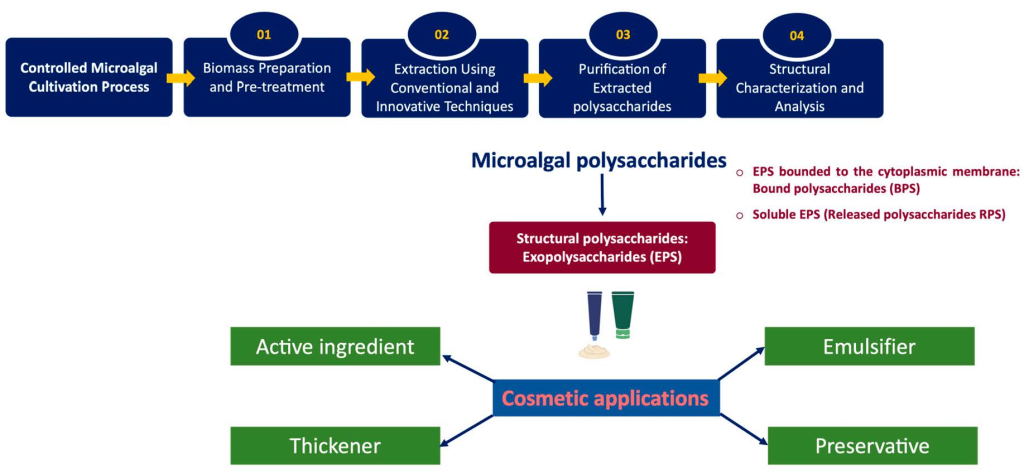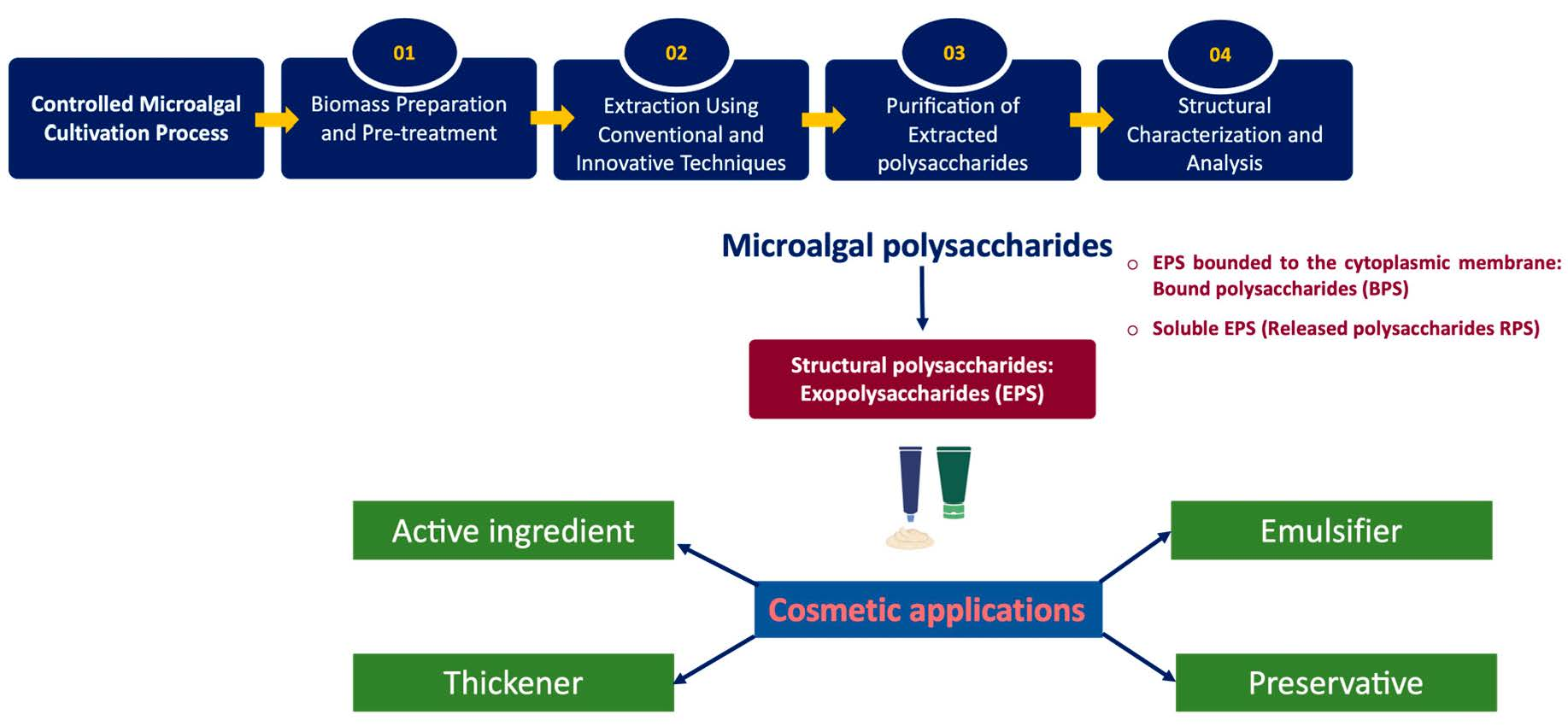The cosmetics industry is increasingly driven by consumer demand for eco-friendly, natural ingredients that offer diverse biological activities. This shift highlights a pressing need for alternatives to synthetic additives, which contribute to environmental micropollutants. Microalgae and cyanobacteria, often regarded as cost-effective renewable resources with higher photosynthetic efficiency than terrestrial biomass, present a promising solution. These microorganisms can be cultivated sustainably, using non-arable land, non-potable water, and even cheap substrates like carbon dioxide from industrial emissions or wastewaters.
A significant issue arises from microalgal cultivation processes, where extracellular polysaccharides (EPSs) are produced simultaneously with biomass and secreted into the culture medium, often ending up as a discarded by-product in waste liquid streams. The valorization and recovery of these EPSs from spent cultivation media offer a practical approach within a biorefinery framework, contributing to economic and environmental sustainability by reducing production costs for other microalgae-derived biocompounds and minimizing waste. EPSs from microalgae and cyanobacteria are particularly attractive for cosmetic applications due to their nontoxic, biodegradable, and biocompatible nature. They hold significant potential for improving both techno-functional and sensorial properties of cosmetic formulations, as well as serving as active ingredients for purposes like hydration and anti-aging. Despite their promise, these EPSs remain underexplored for many potential applications, and their commercial exploitation is still developing, primarily due to higher production costs compared to conventional sources. This review article investigates the current understanding of microalgae and cyanobacteria EPSs as an untapped raw material for cosmetic use, addressing their potential to meet the growing demand for natural and effective ingredients.
Key Findings
• Sustainable and Cost-Effective Sourcing: Microalgae and cyanobacteria are renewable resources that can be grown sustainably, with EPSs recoverable as by-products from cultivation waste streams, contributing to zero-waste biorefineries and reducing overall production costs.
• Diverse Composition and Bioactivity: Microalgae and cyanobacteria EPSs are complex heteropolymers, varying in monosaccharide composition (e.g., xylose, glucose, galactose, rhamnose, fucose, uronic acids) and sulfate content, which directly influences their unique physicochemical and biological functionalities.
• Techno-Functional Properties for Formulations: These EPSs exhibit valuable mechanical properties, including gelling, thickening, emulsifying, stabilizing, and water retention, comparable to commercial industrial polysaccharides like xanthan gum, making them suitable as excipients in cosmetic formulations. They can also function as effective encapsulating agents for active ingredients.
• Antimicrobial and Preservative Potential: Many microalgal and cyanobacterial EPSs demonstrate significant antiviral (e.g., calcium spirulan, nostoflan), antibacterial, and even antifungal activities, positioning them as promising natural preservatives to extend product shelf-life and as active ingredients for skin conditions like acne.
• Potent Antioxidant Activity: Numerous studies confirm the high free radical scavenging and antioxidant capacities of various EPSs, vital for protecting lipid-containing cosmetic products from oxidation and safeguarding skin against oxidative stress and damage.
• Anti-Aging Effects: Specific EPSs can inhibit enzymes responsible for dermal extracellular matrix degradation (e.g., collagenase, elastase, hyaluronidase), stimulate collagen production by human fibroblast lines, and enhance skin hydration, thereby offering significant anti-aging and regenerative properties.
• Anti-Inflammatory and Immunomodulatory Activities: Several EPSs have shown anti-inflammatory effects comparable to ibuprofen and possess immunomodulatory activities, with some strains also aiding in tissue regeneration, making them valuable for soothing and repairing skin.
• Wound Healing and Skin Barrier Repair: Certain EPSs promote fibroblast migration and proliferation and have been successfully incorporated into wound dressings to enhance tissue regeneration and provide antibacterial benefits, thus supporting skin barrier repair.
• Commercial and Patent Landscape: Despite challenges related to production costs, several microalgal EPSs are already being patented and commercialized for cosmetic use, with examples including Silidine®, Epsiline®, and Alguronic acid™, indicating a growing market interest.
The future implications of this research are substantial. To fully realize their potential, significant efforts are required to overcome current challenges, including optimizing production costs, developing more efficient downstream processing methods, and conducting detailed structural and biological characterizations to establish precise structure-activity relationships. The expansion of novel applications and marketable products, coupled with rigorous in vivo testing and clinical studies to ensure safety and compatibility, will be crucial for broader commercial adoption. Ultimately, the valorization of these unique microalgal EPSs from waste streams promises to reduce reliance on synthetic additives, mitigate environmental impact, and pave the way for a new generation of high-value, sustainable, and effective cosmetic and cosmeceutical products.
Link to the study: https://www.mdpi.com/2079-9284/12/5/200


